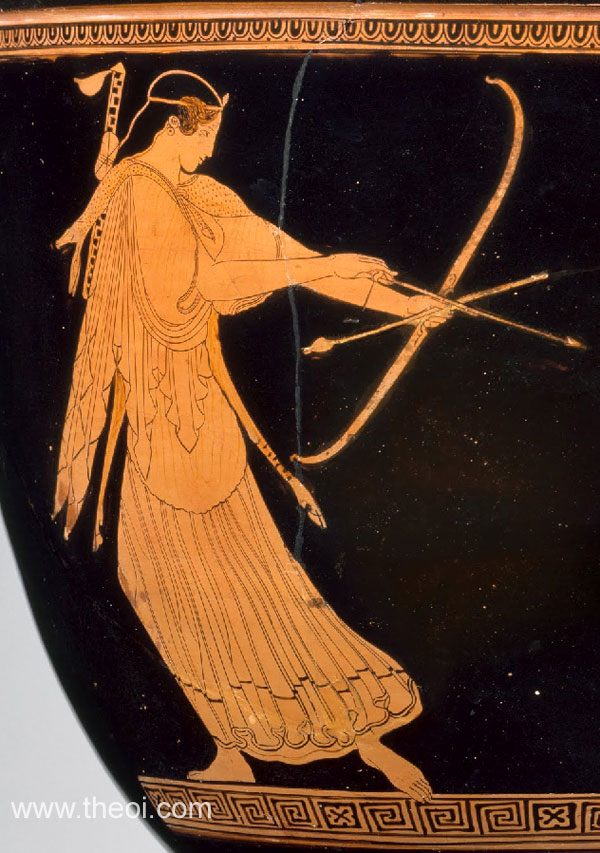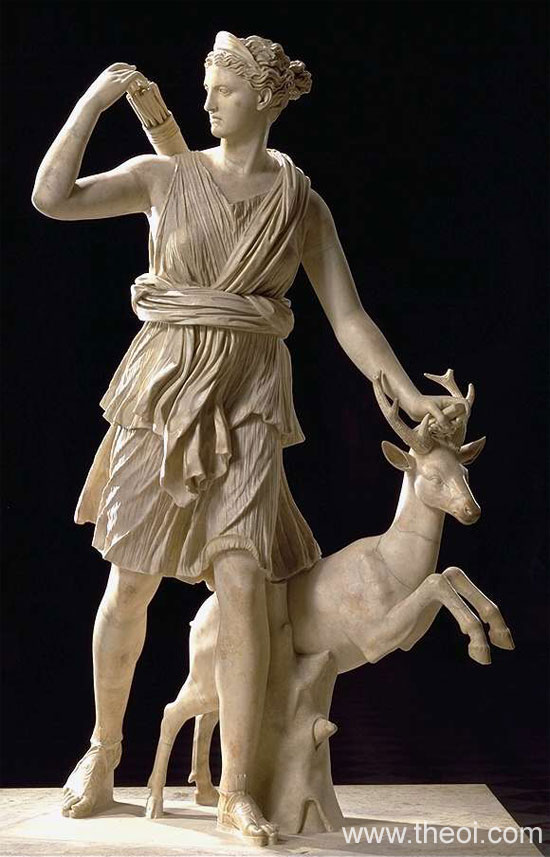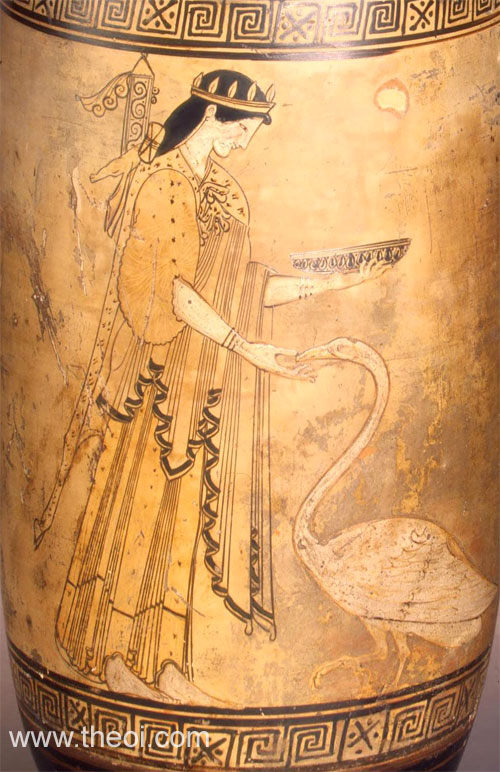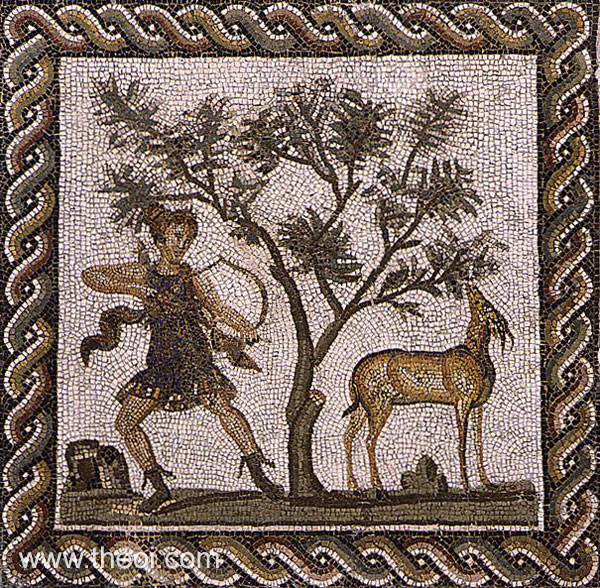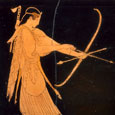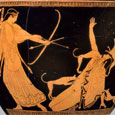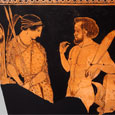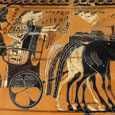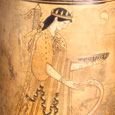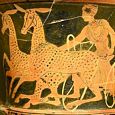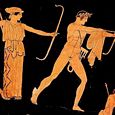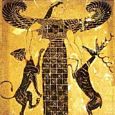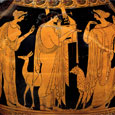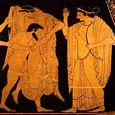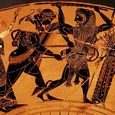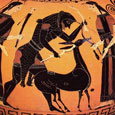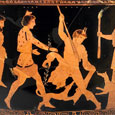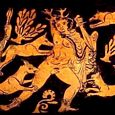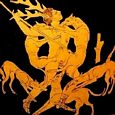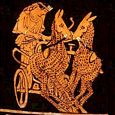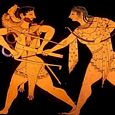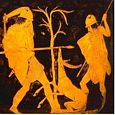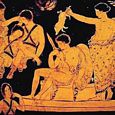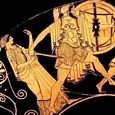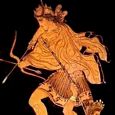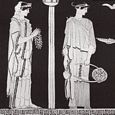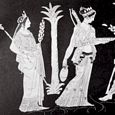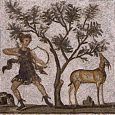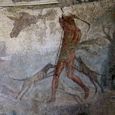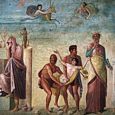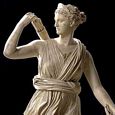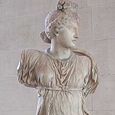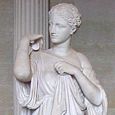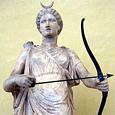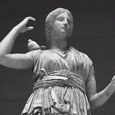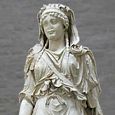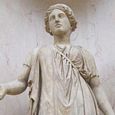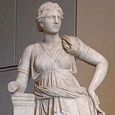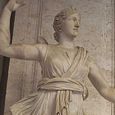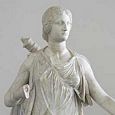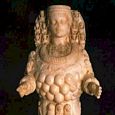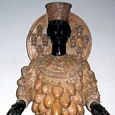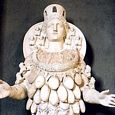ARTEMIS - Greek Goddess of Hunting & Wild Animals (original) (raw)
Greek Mythology >> Greek Gods >> Olympian Gods >> Artemis
Artemis, Athenian red-figure bell krater C5th B.C., Museum of Fine Arts Boston
ARTEMIS was the Olympian goddess of hunting, the wilderness and wild animals. She was also a goddess of childbirth, and the protectress of the girl child up to the age of marriage--her twin brother Apollon was similarly the protector of the boy child. Together the two gods were also bringers of sudden death and disease--Artemis targetted women and girls, Apollon men and boys.
In ancient art Artemis was usually depicted as a girl or young maiden with a hunting bow and quiver of arrows.
MYTHS
Artemis' mother Leto was hounded throughout her pregnancy by the jealous goddess Hera but eventually found refuge on the floating island of Delos. There she gave birth to Artemis who assisted her mother as midwife with the birth of her younger twin-brother Apollon.<<More>>
Kallisto (Callisto) was a handmaiden of the goddess who Zeus seduced by assuming her form. When Artemis discovered the girl was pregnant she transformed her into a bear and exiled her to the wilds. <<More>>
The handsome giant Orion was a companion of the goddess but her jealous brother Apollon tricked her into killing him with a distant bow-shot. In her grief Artemis placed him amongst the stars as the constellation Orion.<<More>>
When the Aloadai (Aloadae) giants tried to storm Olympos, Artemis assumed the form of a doe and raced between them causing the pair to cast their spears, miss, and strike each other dead.<<More>>
The hunter Aktaion (Actaeon) spied upon the goddess as she was bathing with her nymphs at a spring. Angered, she transformed him into a stag and had him torn apart by his own hounds.<<More>>
The giant Kalydonian (Calydonian) Boar was sent by Artemis to ravage the lands of King Oineus as punishment for neglecting her in his sacrifices to the gods.<<More>>
As the Greek fleet was preparing to sail for Troy, King Agamamnon offended Artemis and she becalmed the waters preventing their departure. To appease the goddess the king was forced to sacrifice his own daughter Iphigeneia, but she snatched the girl safely away from the altar and replaced her with a doe.<<More>>
Artemis was a divine ally of the Trojans during the Trojan War. In a clash between the rival factions of gods she confronted Hera, but the Queen of the Gods tore the bow from her hands, beat her about the head, and sent her fleeing back to Olympos in tears. <<More>>
Many other myths are detailed over the following pages.
SYMBOLS & ATTRIBUTES
Artemis' most distinctive attributes were her bow and arrows but she was also sometimes equipped with a quiver, pair of hunting spears, torch, lyre, and/or water-jug.
The goddess was clothed in a knee-length girl's dress or a full-length woman's robe (chiton), with a cloak (chlamys, himation), headgear (a crown, tiara, headband, bonnet or animal-pelt cap), and occasionally the pelt of a deer draped across her shoulders. <<More>>
Below are some examples of her attributes as depicted in ancient Greek art:-
1. Bow & arrows; 2. Quiver; 3. Hunting spears; 4. Torch; 5. Lyre;
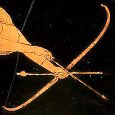
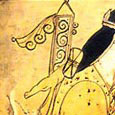
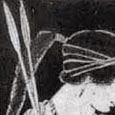
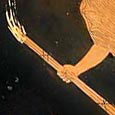
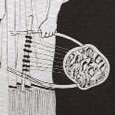
6. Crown; 7. Head-band; 8. Bonnet; 9. Animal-pelt cap; 10. Deer-skin cape.
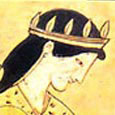
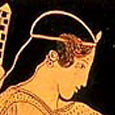
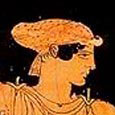
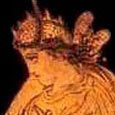
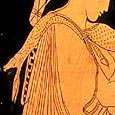
SACRED ANIMALS & PLANTS
Artemis' sacred animal was the deer. She drove a chariot drawn by a pair of the beasts and was often depicted holding or hunting a deer or with a deer-skin cape draped over her shoulders. <<More>>
In myth the most celebrated of her sacred animals was the golden-horned Cerynitian Hind which Herakles was sent to fetch as one of his Twelve Labours. <<More>>
The bear was also sacred to Artemis as well as a variety of water- and ground-birds such as partridges, quails and guinea-fowl.
Her sacred plants were the cypress-tree and the palm-tree. <<More>>
Below are examples of the goddess' animal companions as depicted in ancient Greek art:-
1. Stag; 2. Heron; 3. Doe-drawn chariot.
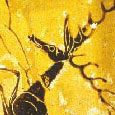
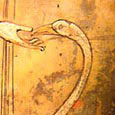
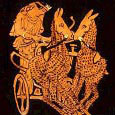
ARTEMIS PAGES ON THEOI.COM
This site contains a total of 15 pages describing the goddess, including general descriptions, mythology, and cult. The content is outlined in the Index of Artemis Pages (left column or below).
FAMILY OF ARTEMIS
PARENTS
[1] ZEUS & LETO (Hesiod Theogony 918, Hesiod Works & Days 770, Homer Iliad 1.9 & 21.495, Homer Odyssey 6.100 & 11.318, Homeric Hymn 27 to Artemis, Orphic Hymn 35, Pindar Nemean Ode 6 & 8, Pindar Processional Song on Delos, Callimachus Hymn to Artemis & Hymn to Delos, Apollodorus 1.21 & 3.46, Pausanias 8.9.1 & 8.53.1. Hyginus Fabulae 9 & 140, et al)
[2] DEMETER (Aeschylus, Pausanias 8.37.3)
OFFSPRING
NONE (she was a virgin goddess)
Artemis was a daughter of Zeus, King of the Gods, and the Titaness Leto and the twin-sister of the god Apollon (Apollo). Her mother was hounded by Zeus' jealous wife Hera throughout her pregnancy and was forced to wander the world in search of safe refuge. She was the first of the twins born and, being a precocious divine child, assisted her mother with the birth of her younger twin brother. <<More>>
Artemis was a granddaughter of four of the elder Titans: Kronos (Cronus), Rheia, Koios (Coeus) and Phoibe (Phoebe). She was a half-sister of many of the other Olympian gods including Athena, Ares, Hermes, Dionysos and Persephone.
Artemis was a virgin goddess but unlike her sister Athena she was often portrayed as a girl child rather than as an adult woman.
Below are two graphics depicting Artemis' family tree, the first with names transliterated from the Greek and the second with the common English spellings:-
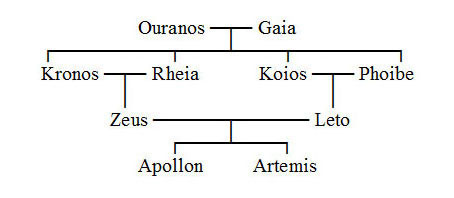
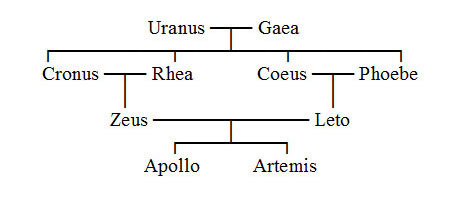
ENCYCLOPEDIA
Artemis-Diana, Greco-Roman marble statue C1st A.D., Musée du Louvre
ARTEMIS, one of the great divinities of the Greeks. Her name is usually derived from artemês, uninjured, healthy, vigorous; according to which she would be the goddess who is herself inviolate and vigorous, and also grants strength and health to others. (Plat. Cratyl. p. 406, b. ; Strab. xiv. p. 635; Eustath. ad Hom. pp. 32, 577, 1732.) According to the Homeric account and Hesiod (Theog. 918) she was the daughter of Zeus and Leto, whence Aeschylus (Sept. 148) calls her lêtôgeneia. She was the sister of Apollo, and born with him at the same time in the island of Delos. According to a tradition which Pausanias (viii. 37. § 3) found in Aeschylus, Artemis was a daughter of Demeter, and not of Leto, while according to an Egyptian story (Herod. ii. 156) she was the daughter of Dionysus and Isis, and Leto was only her nurse. But these and some other legends are only the results of the identification of the Greek Artemis with other local or foreign divinities. The place of her birth is for the same reason not the same in all traditions : some say that it was the grove of Ortygia near Ephesus (Tacit. Annal. iii. 61; Schol. ad Pind. Nem. i. 1), others that it was Crete (Diod. v. 72), and others again, that she was the sister of Apollo, but born somewhat earlier, so that she was able to assist Leto in giving birth to Apollo. (Orph Hymn. 34. 5; Spanheim, ad Callim. p. 476, &c.)
In the description of the nature and character of this goddess, it is necessary to distinguish between the different points of view from which the Greeks regarded her, and also between the really Greek Artemis and certain foreign divinities, who for some resemblance or another were identified by the Greeks with their own Artemis.
1. Artemis as the sister of Apollo, is a kind of female Apollo, that is, she as a female divinity represented the same idea that Apollo did as a male divinity. This relation between the two is in many other cases described as the relation of husband and wife, and there seems to have been a tradition which actually described Artemis as the wife of Apollo. (Eustath. ad Hom. p. 1197.) In the character of sister of Apollo, Artemis is like her brother armed with a bow, quiver, and arrows, and sends plague and death among men and animals : she is a thea apollousa. Sudden deaths, but more especially those of women, are described as the effect of her arrows. (Hom. Il. vi. 205, 427, &c., xix. 59, xxi. 483, &c.; Od. xi. 172, &c., 324, xv. 478, xviii. 202, xx. 61, &c., v. 124, &c.) She also acts sometimes in conjunction with her brother. (Od. xv. 410; Il. xxiv. 606.)
As Apollo was not only a destructive god, but also averted the evils which it was in his power to inflict, so Artemis was at the same time a thea sôteira; that is, she cured and alleviated the sufferings of mortals. Thus, for instance, she healed Aeneas, when he was wounded and carried into the temple of Apollo. (Il. v. 447.) In the Trojan war she sided, like Apollo, with the Trojans. The man whom she looked graciously upon was prosperous in his fields and flocks, his household was thriving, and he died in old age. (Callim. Hymn. in Dian. 129, &c.)
She was more especially the protectress of the young, whence the epithets paidotrophos, kourotrophos, and philomeirax (comp. Diod. v. 73); and Aeschylus (Agam. 142) calls her the protectress of young sucking-animals, and of the game ranging through the forests of the mountains. Artemis thus also came to be regarded as the goddess of the flocks and the chase: she is the huntress among the immortals ; she is called the stag-killer (elaphêbolos), the lover of the tumult connected with the chase (keladeinê), and agrotera. (Il. xxi. 511, 485, &c.; Hom. Hymn. in Dian. 10.)
Artemis is moreover, like Apollo, unmarried; she is a maiden divinity never conquered by love. (Soph. Elect. 1220.) The priests and priestesses devoted to her service were bound to live pure and chaste, and trangressions of their vows of chastity were severely punished. (Paus. vii. 19. § 1. viii. 13. § 1.) She was worshipped in several places together with her brother; and the worship of both divinities was believed to have come from the Hyperboreans, and Hyperborean maidens brought sacrifices to Delos. (Herod. ii. 32, 35.) The laurel was sacred to both divinities, and both were regarded as the founders and protectors of towns and streets. (Paus. i. 38. § 6, iii. 24. § 6, viii. 36, in fin. ; Aeschyl. Sept. 450; Callim. Hymn. in Dian. 34.)
There are, however, some points also, in which there is no resemblance between Artemis and Apollo : she has nothing to do with music or poetry, nor is there any trace of her having been regarded as an oracular divinity like Apollo. Respecting the real and original character of Artemis as the sister of Apollo, we encounter the same difficulties as those mentioned in the article Apollo, viz. as to whether she was a purely spiritual and ethical divinity, as Müller thinks, or whether she was the representative of some power in physical nature; and the question must be decided here in the same manner as in the case of Apollo.
When Apollo was regarded as identical with the sun or Helios, nothing was more natural than that his sister should be regarded as Selene or the moon, and accordingly the Greek Artemis is, at least in later times, the goddess of the moon. Buttmann and Hermann consider this idea of Artemis being the moon as the fundamental one from which all the others are derived. But, at any rate, the idea of Artemis being the goddess of the moon, must be confined to Artemis the sister of Apollo, and is not applicable to the Arcadian, Taurian, or Ephesian Artemis.
2. The Arcadian Artemis is a goddess of the nymphs, and was worshipped as such in Arcadia in very early times. Her sanctuaries and temples were more numerous in this country than in any other part of Greece. There was no connexion between the Arcadian Artemis and Apollo, nor are there any traces here of the ethical character which is so prominent in Artemis, the sister of Apollo. These circumstances, together with the fact, that her surnames and epithets in Arcadia are nearly all derived from the mountains, rivers, and lakes, shew that here she was the representative of some part or power of nature. In Arcadia she hunted with her nymphs on Taygetus, Erymanthus, and Maenalus; twenty nymphs accompanied her during the chase, and with sixty others, daughters of Oceanus, she held her dances in the forests of the mountains. Her bow, quiver, and arrows, were made by Hephaestus, and Pan provided her with dogs. Her chariot was drawn by four stags with golden antlers. (Callim. Hymn. in Dian. 13, 81, 90, &c.; Apollod. ii. 5. § 3; Pind. Ol. iii. 51.) Her temples and sanctuaries in Arcadia were usually near lakes or rivers, whence she was called limnêtis or limnaia. (Paus. ii. 7. § 6, iii. 23. § 6, iv. 4. § 2, 31. § 3, viii. 53. § 5.) In the precincts of her sanctuaries there were often sacred wells, as at Corinth. (Paus. ii. 3. § 5, iii. 20. § 7.) As a nymph, Artemis also appears in connexion with river gods, as with Alpheius, and thus it is intelligible why fish were sacred to her. (Diod. v. 3.)
3. The Taurian Artemis. The legends of this goddess are mystical, and her worship was orgiastic and connected, at least in early times, with human sacrifices. According to the Greek legend there was in Tauris a goddess, whom the Greeks for some reason identified with their own Artemis. and to whom all strangers that were thrown on the coast of Tauris, were sacrificed. (Eurip. Iph. Taur. 36.) Iphigeneia and Orestes brought her image from thence, and landed at Brauron in Attica, whence the goddess derived the name of Brauronia. (Paus. i. 23. § 9, 33. § 1, iii. 16, in fin.) The Brauronian Artemis was worshipped at Athens and Sparta, and in the latter place the boys were scourged at her altar in such a manner that it became sprinkled with their blood. This cruel ceremony was believed to have been introduced by Lycurgus, instead of the human sacrifices which had until then been offered to her. (Dict. of Ant. s. v. Braurônia and Diamastigôsis.)
Her name at Sparta was Orthia, with reference to the phallus, or because her statue stood erect. According to another tradition, Orestes and Iphigeneia concealed the image of the Taurian goddess in a bundle of brushwood, and carried it to Aricia in Latium. Iphigeneia, who was at first to have been sacrificed to Artemis, and then became her priestess, was afterwards identified with the goddess (Herod. iv. 103; Paus. i. 43. § 1), who was worshipped in some parts of Greece, as at Hermione, under the name of Iphigeneia. (Paus. ii. 35. § 1.) Some traditions stated, that Artemis made Iphigeneia immortal, in the character of Hecate, the goddess of the moon.
A kindred divinity, if not the same as the Taurian Artemis, is Artemis tauropolos, whose worship was connected with bloody sacrifices, and who produced madness in the minds of men, at least the chorus in the Ajax of Sophocles, describes the madness of Ajax as the work of this divinity. In the legends about the Taurian Artemis, it seems that separate local traditions of Greece are mixed up with the legends of some Asiatic divinity, whose symbol in the heaven was the moon, and on the earth the cow.
4. The Ephesian Artemis was a divinity totally distinct from the Greek goddess of the same name. She seems to have been the personification of the fructifying and all-nourishing powers of nature. It is an opinion almost universally adopted, that she was an ancient Asiatic divinity whose worship the Greeks found established in Ionia, when they settled there, and that, for some resemblance they discovered, they applied to her the name of Artemis. As soon as this identity of the Asiatic goddess with the Greek Artemis was recognised, other features, also originally peculiar to the Greek Artemis, were transferred to her; and thus she is called a daughter of Leto, who gave birth to her in the neighbourhood of Ephesus. Her original character is sufficiently clear from the fact, that her priests were eunuchs, and that her image in the magnificent temple of Ephesus represented her with many breasts (polumastos). The whole figure of the goddess resembled a mummy : her head was surmounted with a mural crown (corona muralis), and the lower part of her body, which ended in a point, like a pyramid upside down, was covered with figures of mystical animals. (Strab. xiv. p. 641; Paus. iv. 31. § 6, vii. 5. § 2., The symbol of this divinity was a bee, and her highpriest bore the name of king (essên). Her worship was said to have been established at Ephesus by the Amazons. (Paus. ii. 7. § 4, viii. 12. § 1; Hesych. and Suid. s. v. essên.)
Respecting some other divinities, or attributes of divinities, which were likewise regarded as identical with Artemis in Greece, see Britomartis, Dictynna, and EileithyiaI. The Romans identified their goddess Diana with the Greek Artemis, and at a comparatively early time they transferred to their own goddess all the peculiar features of the Greek Artemis. The worship of Artemis was universal in all Greece, in Delos, Crete, Sicily, and southern Italy, but more especially in Arcadia and the whole of the Peloponnesus. The sacrifices offered to the Brauronian Artemis consisted of stags and goats; in Thrace dogs were offered to Artemis. Among the animals sacred to the Greek Artemis we may mention the stag, boar, dog, and others; the fir-tree was likewise sacred to her.
It is impossible to trace the various relations in which Artemis appears to us to one common source, or to one fundamental idea : the very manner in which such a complicated mythus was formed renders the attempt futile, or, to say the least, forced. In the case of Artemis, it is evident, that new elements and features were added in various places to the ancient local mythus; the worship of one divinity is identified with that of another, and the legends of the two are mixed up into one, or those of the one are transferred to the other, whose legends then sink into oblivion.
The representations of the Greek Artemis in works of art are different accordingly as she is represented either as a huntress, or as the goddess of the moon; yet in either case she appears as a youthful and vigorous divinity, as becomes the sister of Apollo. As the huntress, she is tall, nimble, and has small hips; her forehead is high, her eyes glancing freely about, and her hair tied up behind in such a manner, that some locks float down her neck; her breast is covered, and the legs up to the knees are naked, the rest being covered by the chlamys. Her attributes are the bow, quiver, and arrows, or a spear, stags, and dogs. As the goddess of the moon, she wears a long robe which reaches down to her feet, a veil covers her head, and above her forehead rises the crescent of the moon. In her hand she often appears holding a torch.
Source: Dictionary of Greek and Roman Biography and Mythology.
CLASSICAL LITERATURE QUOTES
HYMNS TO ARTEMIS
Artemis, Athenian-red figure lekythos C5th B.C., State Hermitage Museum
I) THE HOMERIC HYMNS
Homeric Hymn 9 to Artemis (trans. Evelyn-White) (Greek epic C7th to 4th B.C.) :
"Mousa (Muse), sing of Artemis, sister of the far-shooter (hekatos), Parthenos the virgin who delights in arrows (iokheaira), who was fostered with Apollon. She waters her horses from Meles deep in reeds [a river in Lydia], and swifty drives her all-golden chariot through Smyrna to vine-clad Klaros (Claros) where Apollon god of the silver bow (argyrotoxos), sits waiting for far-shooting delighter in arrows (hekatebolon iokheaira).
And so hail to you, Artemis, in my song and to all goddesses as well. Of you first I sing and with you I begin; now that I have begun with you, I will turn to another song."
Homeric Hymn 27 to Artemis :
"I sing of Artemis with shafts are of gold (khryselakatos), strong-voiced (keladeine), the revered virgin (parthenon aidoin), dear-shooting (elaphebolos), delighter in arrows (iokheaira), own sister to Apollon of the golden sword (khrysaor). Over the shadowy hills and windy peaks she draws her golden bow, rejoicing in the chase, and sends out grievous shafts. The tops of the high mountains tremble and the tangled wood echoes awesomely with the outcry of beasts: earth quakes and the sea also where fishes shoal. But the goddess with a bold heart turns every way destroying the race of wild beasts: and when she is satisfied and has cheered her heart, then the huntress who delights in arrows (theroskopos iokheaira) slackens her supple bow and goes to the great house of her dear brother Phoibos Apollon, to the rich land of Delphoi, there to order the lovely dance of the Mousai (Muses) and Kharites (Charites, Graces). There she hangs up her curved bow and her arrows, and heads and leads the dances, gracefully arrayed, while all they utter their heavenly voice, singing how neat-ankled Leto bare children supreme among the immortals both in thought and deed.
Hail to you, children of Zeus and rich-haired Leto! And now I will remember you and another song also."
Homeric Hymn 5 to Aphrodite 18 ff :
"Artemis with shafts of gold (khryselakatos) loves archery and the slaying of wild beasts in the mountains, the lyre also and dancing and strong-voiced song and shady woods and the cities of upright men."
II) HELLENISTIC HYMNS
Callimachus, Hymn 3 to Artemis (trans. Mair) (Greek poet C3rd B.C.) :
"Of Artemis we hymn--no light thing is it for singers to forget her - whose study is the bow and the shooting of hares and the spacious dance and sport upon the mountains.
[The story of her birth and childhood follow, see The Childhood of Artemis for this part of the hymn.] . . .
The fourth time [Artemis shot her bow]--not long was it ere thou didst shoot at the city of unjust me, those who to one another and those who towards strangers wrought many deeds of sin, forward men, on whom thou wilt impress thy grievous wrath. On their cattle plague feeds, on their tilth feeds frost, and the old men cut their hair in mourning over their sons, and their wives either are smitten or die in childbirth, or, if they escape, bear birds whereof none stands on upright ankle.
But on whomsoever thou lookest smiling and gracious, for them the tilth bears the corn-ear abundantly, and abundantly prospers the four-footed breed, and abundant waxes their prosperity: neither do they go to the tomb, save when they carry thither the aged. Nor does faction wound their race--faction which ravages even the well-established houses: but brother's wife and husband's sister set their chairs around one board . . .
Lady, of that number be whosoever is a true friend of mine, and of that number may I be myself, O Queen. And may song be my study forever. In that song shall be the Marriage of Leto; therein thy name shall often-times be sung; therein shall Apollon be and therein all thy labours, and therein thy hounds and thy bow and thy chariot, which lightly carry thee in thy splendour, when thou drivest to the house of Zeus . . .
But when the Nymphai (Nymphs) encircle thee in the dance, near the springs of Aigyptian (Egyptian) Inopos [on the island of Delos] or Pitane [in Aiolia or Lakonia]--for Pitane too is thine--or in Limnai [in Lakonia] or where, goddess, thou camest from Skythia (Scythia) to dwell, in Alai Araphenides [i.e. Brauron in Attika], renouncing the rites of the Tauroi [of Skythia], then may not my kine cleave a four-acred fallow field for a wage at the hand of an alien ploughman; else surely lame and weary of neck would they come to the byre, yea even were they of Stymphaian breed, nine years of age, drawing by the horns; which kine are far the best for cleaving a deep furrow; for the god Helios never passes by that beauteous dance, but stays his car to gaze upon the sight, and the lights of day are lengthened.
Which now of islands, what hill finds most favour with thee? What haven? What city? Which of the Nymphai (Nymphs) dost thou love above the rest, and what heroines hast thou taken for thy companions? Say, goddess, thou to me, and I will sing thy saying to others. Of islands, Dolikhe [Ikaria] hath found favour with thee, of cities Perge [in Pamphylia], of hills Taygetos [in Lakedaimonia], the havens of Euripos [in Euboia].
And beyond others thou lovest the Nymphe of Gortyn, Britomartis, slayer of stags, the goodly archer . . . Yea and Kyrene (Cyrene) thou madest thy comrade, to whom on a time thyself didst give two hunting dogs, with whom the maiden daughter of Hypseus beside the Iolkian tomb won the prize.And the fair-haired [Prokris (Procris)] wife of Kephalos (Cephalus), son of Deioneus, O Lady, thou madest thy fellow in the chase and fair Antikleia [mother of Odysseus], they say, thou dist love even as thine own eyes. These were the first who wore the gallant bow and arrow-holding quivers on their shoulders; their right shoulders bore the quiver strap, and always the right breast showed bare. Further thou dist greatly commend swift-footed Atalanta, the slayer of boards, daughter of Arkadian Iasios (Arcadian Iasius), and taught her hunting with dogs and good archery . . .
Lady of many shrines, of many cities, hail! Khitone (Goddess of the Tunic), sojourner in Miletos; for thee did Neleus [i.e. the founder of Miletos] make his Guide, when he put off with his ships from the land of Kekrops (Cecrops) [i.e. Attika].
Khesias (Chesias) (Lady of Khesion) and Imbrasia (Lady of Imbrasos), throned in the highest, to thee in thy shrine did Agamemnon dedicate the rudder of his ship, a charm against ill weather, when thou didst bind the winds for him, what time the Akhaian (Achaean) ships sailed to vex the cities of the Teukroi [i.e. the Trojans], wroth for Rhamnusian Helene.
For thee surely Proitos (Proetus) established two shrines, one of Artemis Kore (Core) (Maidenhood) for that thou dist gather for him his maiden daughters, when they were wandering over the Azanian hills; the other he founded in Lousa to Artemis Hemere (the Gentle), because thou tookest from his daughters the spirit of wildness.
For thee, too, the Amazones (Amazons), whose mind is set on war, in Ephesos (Ephesus) beside the sea established an image beneath an oak trunk, and Hippo [an Amazon queen] performed a holy rite for thee, and they themselves, O Oupis (Opis) Queen, around the image danced a war-dance--first in shields and armour, and again in a circle arraying a spacious choir. And the loud pipes thereto piped shrill accompaniment, that they might foot the dance together (for not yet did they pierce the bones of the fawn [to create flutes], Athene's handiwork, a bane to the deer). And the echo reached unto Sardis and to the Berekynthian range [in Phrygia]. And they with their feet geat loudly and therewith their quivers rattled. And afterwards around that image was raised a shrine of broad foundations. That it shall dawn behold nothing more divine, naught richer. Easily would it outdo Pytho [Delphoi].
Wherefore in this madness insolent Lygdamis threatened that he would lay it waste, and brought against it a host of Kimmerians (Cimmerians) which milk mares, in number as the sand; who have their homes hard by the Straights of the cow, daughter of Inakhos (Inachus). Ah! Foolish among kings, how greatly he sinned! For not destined to return again to Skythia was either he or any other of those whose wagons stood in the Kaytrian plain [of Lydia]; for thy shafts are ever more set as a defense before Ephesos. O Mounikhia (Munichia) (Lady of Mounykhia), Limenoskope (Watcher of Harbours), hail, Pheraia (Pheraea) (Lady of Pherai)!
Let none disparage Artemis. For Oineus (Oeneus) dishonoured her altar and no pleasant struggles came upon his city.
Nor let any contend with her in shooting of stags or in archery. For the son of Atreus [Agamemnon] vaunted him not that he suffered small requital. Neither let any woo the Maiden; for not Otos (Otus), nor Orion wooed her to their own good. Nor let any shun the yearly dance; for not tearless to Hippo [an Amazon queen] was her refusal to dance around the altar. Hail, great queen, and graciously greet my song."
III) THE ORPHIC HYMNS
Orphic Hymn 2 to Prothhyraea (trans. Taylor) (Greek hymns C3rd B.C. to 2nd A.D.) :
"To Prothyraia [Artemis], Fumigation from Storax. O venerable Goddess, hear my prayer, for labour pains are thy peculiar care. In thee, when stretched upon the bed of grief, the sex, as in a mirror, view relief. Guard of the race, endued with gentle mind, to helpless youth benevolent and kind; benignant nourisher; great nature's key belongs to no divinity but thee. Thou dwellest with all immanifest to sight, and solemn festivals are thy delight. Thine is the task to loose the virgin's zone and thou in every work art seen and known. With births you sympathise, though pleased to see the numerous offspring of fertility. When racked with labour pangs, and sore distressed the sex invoke thee, as the soul's sure rest; for thou Eileithyia alone canst give relief to pain, which art attempts to ease, but tries in vain. Artemis Eileithyia, venerable power, who bringest relief in labour's dreadful hour; hear, Prothyraia and make the infant race thy constant care."
Orphic Hymn 36 to Artemis :
"To Artemis, Fumigation from Manna. Hear me, Zeus' daughter, celebrated queen, Bromia and Titanis, of a noble mien: in darts rejoicing, and on all to shine, torch-bearing Goddess, Diktynna (Dictynna) divine. Over births presiding, and thyself a maid, to labour pangs imparting ready aid: dissolver of the zone, and wrinkled care, fierce huntress, glorying in the sylvan war: swift in the course, in dreadful arrows skilled, wandering by night, rejoicing in the field: of manly form, erect, of bounteous mind, illustrious Daimon, nurse of humankind: immortal, earthly, bane of monsters fell, 'tis thine, blest maid, on woody mounts to dwell: foe of the stag, whom woods and dogs delight, in endless youth you flourish fair and bright. O universal queen, august, divine, a various form, Kydonian power, is thine. Dread guardian Goddess, with benignant mind, auspicious come, to mystic rites inclined; give earth a store of beauteous fruits to bear, send gentle peace, and health with lovely hair, and to the mountains drive disease and care."
PHYSICAL DESCRIPTIONS OF ARTEMIS
Artemis hunting deer, Greco-Roman mosaic from Utica C3rd A.D., Bardo National Museum
Classical literature provides only a few, brief descriptions of the physical characteristics of the gods.
Homer, Odyssey 6. 102 ff (trans. Shewring) (Greek epic C8th B.C.) :
"With head and forehead Artemis overtops the rest [of her companion Nymphai], and though all are lovely, there is no mistaking which is she."
Homer, Odyssey 6. 151 ff :
"[Odysseus addresses Nausikaa (Nausicaa):] ‘You are most like Artemis, daughter of sovereign Zeus; you are tall as she is, lovely as she is, you have her air.’"
Homer, Odyssey 17. 37 & 19. 54 :
"Penelope came from her room, looking like Artemis [i.e. in chastity] or like golden Aphrodite [i.e. in beauty]."
Apollonius Rhodius, Argonautica 3. 879 ff (trans. Rieu) (Greek epic C3rd B.C.) :
"Artemis, standing in her golden chariot after she has bathed in the gently water of Parthenios or the streams of Amnisos, and driving off with her fast-trotting deer over the hills and far away to some rich-scented sacrifice. Attendant Nymphai (Nymphs) have gathered at the source of Amnisos or flocked in from the glens and upland springs to follow her; and fawning beasts whimper in homage and tremble as she passes by."
Callimachus, Hymn 3 to Artemis 10 ff (trans. Mair) (Greek poet C3rd B.C.) :
"Give me [Artemis] arrows and a bow . . . and give me to gird me in a tunic with embroidered border reaching to the knee, that I may slay wild beasts."
Pausanias, Description of Greece 5. 19. 5 (trans. Jones) (Greek travelogue C2nd A.D.) :
"[Amongst the figures depicted on the chest of Kypselos (Cypselus) dedicated at Olympia:] Artemis has wings on her shoulders . . . in her right hand she grips a leopard, in her left a lion."
Pausanias, Description of Greece 8. 37. 1 :
"[From a description of a cult statue:] Artemis wrapped in the skin of a deer, and carrying a quiver on her shoulders, while in one hand she holds a torch, in the other two serpents; by her side a bitch, of a breed suitable for hunting, is lying down."
Ovid, Metamorphoses 3. 138 ff (trans. Melville) (Roman epic C1st B.C. to C1st A.D.) :
"She [Artemis] stood taller, a head taller than them all [her attendant Nymphai (Nymphs)]."
Nonnus, Dionysiaca 48. 302 ff (trans. Rouse) (Greek epic C5th A.D.) :
"[Artemis] and maiden Aura mounted the car [Artemis' chariot], took reins and whip and drove the horned team [of deer] like a tempest. The unveiled daughters of everflowing Okeanos (Oceanus) her servants made haste to accompany the Archeress: one moved her swift knees as her queen's forerunner, another tucked up her tunic and ran level not far off, a third laid a hand on the basket of the swiftmoving car and ran alongside. Archeress diffusing radiance from her face stood shining above her attendants . . . The goddess [Artemis] leapt out of her car [of her chariot]; Oupis (Opis) took the bow from her shoulders, and Hekaerge the quiver; the daughters of Okeanos took off the well-strung hunting nets, and another took charge of the dogs; Loxo loosed the boots from her feet."
ANCIENT GREEK & ROMAN ART
K6.1 Artemis with Bow
Athenian Red Figure Vase Painting C5th B.C.
K6.1B Artemis & Actaeon
Athenian Red Figure Vase Painting C5th B.C.
T61.1 Artemis & Marsyas
Lucanian Red Figure Vase Painting C4th B.C.
K16.1 Artemis, Athena, Moirae
Athenian Black Figure Vase Painting C6th B.C.
K6.2 Artemis with Heron
Athenian Red Figure Vase Painting C5th B.C.
K6.10 Artemis Riding Deer Chariot
Italian Red Figure Vase Painting C5th B.C.
K5.4 Artemis, Apollo, Niobides
Athenian Red Figure Vase Painting C5th B.C.
K6.3 Artemis Queen of Beasts
Athenian Black Figure Vase Painting C6th B.C.
T14.6 Artemis, Leto, Apollo
Athenian Red Figure Vase Painting C6th B.C.
T14.4 Artemis, Leto, Tityus, Apollo
Athenian Red Figure Vase Painting C5th B.C.
K5.6 Artemis, Apollo, Heracles
Athenian Black Figure Vase Painting C6th B.C.
M22.3 Artemis, Heracles, Hind
Athenian Red Figure Vase Painting C6th B.C.
K6.9 Artemis & Actaeon
Athenian Red Figure Vase Painting C5th B.C.
K6.7 Artemis & Actaeon
Lucanian Red Figure Vase Painting C4th B.C.
K6.8 Death of Actaeon
Apulian Red Figure Vase Painting C4th B.C.
K6.6 Artemis & Actaeon
Athenian Red Figure Vase Painting C5th B.C.
K5.5 Artemis, Apollo, Heracles
Athenian Red Figure Vase Painting C6th B.C.
L10.1 Artemis & the Aloadae
Athenian Red Figure Vase Painting C5th B.C.
T40.6 Artemis, Apollo, Orestes
Apulian Red Figure Vase Painting C4th B.C.
K10.9 Artemis, Aphrodite, Paris
Athenian Red Figure Vase Painting C5th B.C.
K6.5 Artemis with Bow
Athenian Red Figure Vase Painting C4th B.C.
T14.2 Artemis, Leto, Apollo
Athenian Red Figure Vase Painting C5th B.C.
T14.7 Artemis, Leto, Apollo
Athenian Red Figure Vase Painting C5th B.C.
Z6.1 Artemis Hunting a Deer
Greco-Roman Utica Floor Mosaic C3rd A.D.
F6.2 Artemis & Actaeon
Greco-Roman Pompeii Wall Fresco C1st A.D.
F6.1 Artemis, Sacrifice Iphigenia
Greco-Roman Pompeii Wall Fresco C1st A.D.
S6.1 Artemis-Diana
Greco-Roman Marble Statue
S6.3 Artemis-Diana
Greco-Roman Marble Statue
S6.5 Artemis-Diana
Greco-Roman Marble Statue
S6.6 Artemis-Diana
Greco-Roman Marble Statue
S6.7 Artemis-Diana
Greco-Roman Marble Statue
S6.8 Artemis-Diana
Greco-Roman Marble Statue
S6.9 Artemis-Diana
Greco-Roman Marble Statue
S6.4 Artemis-Diana
Greco-Roman Marble Statue
S6.10 Artemis-Diana
Greco-Roman Marble Statue
S6.13 Artemis-Diana
Greco-Roman Marble Statue
S6.2 Ephesian Artemis
Greco-Roman Marble Statue
S6.11 Ephesian Artemis
Greco-Roman Marble Statue
S6.12 Ephesian Artemis
Greco-Roman Marble Statue
SOURCES (ALL ARTEMIS PAGES)
GREEK
- Homer, The Iliad - Greek Epic C8th B.C.
- Homer, The Odyssey - Greek Epic C8th B.C.
- Hesiod, Theogony - Greek Epic C8th - 7th B.C.
- Hesiod, Catalogues of Women Fragments - Greek Epic C8th - 7th B.C.
- Hesiod, Astronomy Fragments - Greek Epic C8th - 7th B.C.
- The Homeric Hymns - Greek Epic C8th - 4th B.C.
- Epic Cycle, The Cypria Fragments - Greek Epic C7th - 6th B.C.
- Epic Cycle, The Aethiopis Fragments - Greek Epic C8th B.C.
- Pindar, Odes - Greek Lyric C5th B.C.
- Pindar, Fragments - Greek Lyric C5th B.C.
- Greek Lyric I Alcaeus, Fragments - Greek Lyric C6th B.C.
- Greek Lyric I Sappho, Fragments - Greek Lyric C6th B.C.
- Greek Lyric III Stesichorus, Fragments - Greek Lyric C7th - 6th B.C.
- Greek Lyric IV Bacchylides, Fragments - Greek Lyric C5th B.C.
- Greek Lyric V Cinesias, Fragments - Greek Lyric C5th B.C.
- Greek Elegaic Theognis, Fragments - Greek Elegaic C6th B.C.
- Aeschylus, Agamemnon - Greek Tragedy C5th B.C.
- Aeschylus, Seven Against Thebes - Greek Tragedy C5th B.C.
- Aeschylus, Suppliant Women - Greek Tragedy C5th B.C.
- Aeschylus, Fragments - Greek Tragedy C5th B.C.
- Aristophanes, Frogs - Greek Comedy C5th - 4th B.C.
- Aristophanes, Thesmophoriazusae - Greek Comedy C5th - 4th B.C.
- Herodotus, Histories - Greek History C5th B.C.
- Plato, Cratylus - Greek Philosophy C4th B.C.
- Plato, Theaetetus - Greek Philosophy C4th B.C.
- Apollodorus, The Library - Greek Mythography C2nd A.D.
- Apollonius Rhodius, The Argonautica - Greek Epic C3rd B.C.
- Callimachus, Hymns - Greek Poetry C3rd B.C.
- Callimachus, Fragments - Greek Poetry C3rd B.C.
- Parthenius, Love Romances - Greek Mythography C1st B.C.
- Diodorus Siculus, The Library of History - Greek History C1st B.C.
- Strabo, Geography - Greek Geography C1st B.C. - C1st A.D.
- Pausanias, Description of Greece - Greek Travelogue C2nd A.D.
- Plutarch, Lives - Greek Historian C1st - 2nd A.D.
- Plutarch, Parallel Stories - Greek Historian C1st - 2nd A.D.
- The Orphic Hymns - Greek Hymns C3rd B.C. - C2nd A.D.
- Antoninus Liberalis, Metamorphoses - Greek Mythography C2nd A.D.
- Aelian, On Animals - Greek Natural History C2nd - 3rd A.D.
- Aelian, Historical Miscellany - Greek Rhetoric C2nd - 3rd A.D.
- Philostratus the Elder, Imagines - Greek Rhetoric C3rd A.D.
- Philostratus the Younger, Imagines - Greek Rhetoric C3rd A.D.
- Philostratus, Life of Apollonius of Tyana - Greek Biography C2nd A.D.
- Ptolemy Hephaestion, New History - Greek Mythography C1st - 2nd A.D.
- Quintus Smyrnaeus, Fall of Troy - Greek Epic C4th A.D.
- Nonnus, Dionysiaca - Greek Epic C5th A.D.
- Colluthus, The Rape of Helen - Greek Epic C5th - 6th A.D.
ROMAN
- Hyginus, Fabulae - Latin Mythography C2nd A.D.
- Hyginus, Astronomica - Latin Mythography C2nd A.D.
- Ovid, Metamorphoses - Latin Epic C1st B.C. - C1st A.D.
- Ovid, Fasti - Latin Poetry C1st B.C. - C1st A.D.
- Ovid, Heroides - Latin Poetry C1st B.C. - C1st A.D.
- Virgil, Aeneid - Latin Epic C1st B.C.
- Cicero, De Natura Deorum - Latin Rhetoric C1st B.C.
- Pliny the Elder, Natural History - Latin Encyclopedia C1st A.D.
- Seneca, Hercules Furens - Latin Tragedy C1st A.D.
- Seneca, Oedipus - Latin Tragedy C1st A.D.
- Seneca, Phaedra - Latin Tragedy C1st A.D.
- Seneca, Troades - Latin Tragedy C1st A.D.
- Valerius Flaccus, The Argonautica - Latin Epic C1st A.D.
- Statius, Thebaid - Latin Epic C1st A.D.
- Statius, Achilleid - Latin Epic C1st A.D.
- Statius, Silvae - Latin Poetry C1st A.D.
BYZANTINE
- Photius, Myriobiblon - Byzantine Greek Scholar C9th A.D.
- Suidas, The Suda - Byzantine Greek Lexicon C10th A.D.
OTHER SOURCES
Source status of Artemis pages:- Fully quoted: Homer (Iliad & Odyssey), Hesiod; Homeric Hymns, Homerica, Apollodorus, Pausanias, Strabo, Herodotus, Orphic Hymns, Quintus Smyrnaeus, Callimachus, Aelian (On Animals), Ovid (Metamorphoses), Hyginus (Fabulae & Astronomica), Apuleius, Aesop; Partially or not quoted (Greek): Pindar, Greek Lyric (Fragments), Greek Elegaic (Fragments), Apollonius Rhodius, Diodorus Siculus, Antoninus Liberalis, Euripides, Aeschylus, Sophocles, Aristophanes, Plato, Theocritus, Lycophron, Plutarch, Philostratus & Callistratus, Nonnus, Oppian, Tryphiodorus, et. al.; Partially or not quoted (Latin): Ovid (Fasti), Cicero, Statius, Colluthus, Propertius, Valerius Flaccus, et. al.
BIBLIOGRAPHY
A complete bibliography of the translations quoted on this page.
